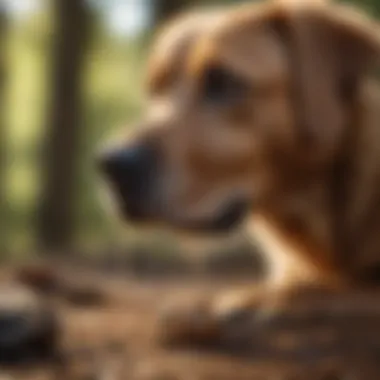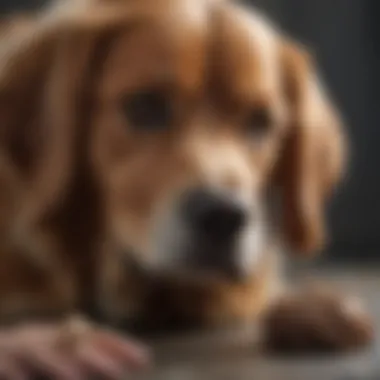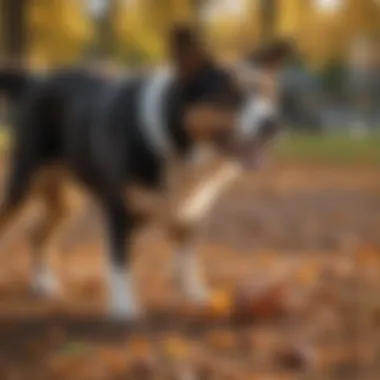Understanding Coprophagia: Why Dogs Eat Feces


Intro
Coprophagia, or the consumption of feces by dogs, raises intrigue among pet owners and animal behaviorists alike. This phenomenon occurs in various species, but is particularly notable in canines. Understanding why some dogs exhibit this behavior is essential for promoting health and hygiene. In this section, we will delve into the underlying reasons for coprophagia, the potential health implications, and effective methods to deter this unsettling behavior.
Animal Overview
Common Names
The common name for the species involved in coprophagia is the domestic dog, scientifically known as Canis lupus familiaris. These animals have long been companions to humans, serving various roles in society from work to companionship.
Scientific Classification
The classification of the domestic dog is as follows:
- Kingdom: Animalia
- Phylum: Chordata
- Class: Mammalia
- Order: Carnivora
- Family: Canidae
- Genus: Canis
- Species: Canis lupus
- Subspecies: Canis lupus familiaris
Geographic Range
Domestic dogs are found all over the world. Their adaptability to various environments, from urban settings to rural landscapes, has contributed to their widespread presence. This behavior can be observed globally, although it might manifest differently depending on individual circumstances.
Behavior and Social Structure
Social Behavior
Dogs are inherently social animals. They thrive in groups, which impacts their behavior significantly. Coprophagia can sometimes be linked to social dynamics, such as competition for resources or submission to pack members.
Communication
Communication among dogs includes barks, body language, and odor exchanges. In some contexts, the smell of feces may attract a dog due to its strong scent, which serves as a form of communication within their species.
Mating and Reproduction
Reproductive behavior in dogs may not directly link to coprophagia, but the presence of feces can indicate territory or attract potential mates. Understanding these dynamics is key to comprehending why some dogs are drawn to feces.
Habitat and Ecosystem
Natural Habitat
Typically, domestic dogs reside in human-created environments, ranging from homes to shelters. Understanding this is crucial, as their surroundings can influence their behaviors, including coprophagia.
Food Sources and Diet
A dog's diet can influence coprophagic behavior. Nutritional deficiencies may drive some dogs to seek alternative sources, including feces, which they may perceive as containing undigested nutrients.
Role in Ecosystem
Though domestic dogs are not wild, they still play a role in the ecosystems they inhabit. Their behavior can impact wildlife and other pets. Coprophagia can affect waste management within a household, impacting overall hygiene.
The behaviors exhibited by dogs, including coprophagia, serve as a pivotal reminder of their complex nature as companions and their need for understanding and care.
In summary, coprophagia in dogs is not just an odd quirk; it is a multifaceted behavior that stems from natural instincts, environmental conditions, and social structures. As we explore this subject further, we will uncover practical approaches for managing and mitigating this behavior effectively.


Prologue to Canine Coprophagia
Coprophagia, the act of consuming feces, is a behavior that raises eyebrows among dog owners. Understanding this phenomenon is vital for effective pet care and health management. Knowledge about coprophagia can prevent potential health risks for dogs and improve the relationship between pets and their owners. By recognizing this behavior, owners can take appropriate measures to address it.
Defining Coprophagia
Coprophagia refers specifically to the act of dogs eating feces, either their own or that of other animals. This behavior is not uncommon among canines, and it can stem from various motivations. Owners often find this behavior unpleasant, but it is essential to approach it without judgment. A clear definition helps in identifying instances when a dog engages in coprophagia, leading to better understanding and management.
Historical Context
Historically, coprophagia is acknowledged in multiple animal species, not just dogs. In the wild, consuming feces can be a survival tactic. Various animals may do this to obtain extra nutrients or remove scent markers from their territory. In domestic dogs, however, the reasons may be more complex, influenced by both instinctual behaviors and environmental factors. Understanding the history of this behavior provides context for its presence in modern pet ownership. By studying past behaviors of canines and how they have adapted through domestication, owners can better comprehend their pets' actions today.
Common Reasons Dogs Eat Feces
Understanding the reasons dogs indulge in coprophagia is crucial for dog owners. This behavior can stem from various factors, including nutritional deficiencies and behavioral issues. Recognizing these causes can help owners address the matter effectively and maintain their pet's health. It also promotes better ownership practices by offering insights into canine behavior.
Nutritional Deficiencies
Many dogs may eat feces due to nutritional deficiencies. For example, if a dog's diet lacks essential nutrients, they might seek alternative sources, including feces, to meet those needs. This behavior highlights the importance of providing a balanced diet and ensuring that all nutritional requirements are met.
Key Nutritional Elements to Consider
- Protein content
- Vitamins and minerals
- Overall diet composition
If a dog is consuming feces out of hunger for nutrients, it is vital to consult with a veterinarian. They can assess the dog's diet and suggest necessary adjustments.
Behavioral Issues
Anxiety and Stress
Anxiety and stress are significant contributors to coprophagia. Dogs experiencing these feelings can result in compulsive behaviors, including eating feces. This behavior can become a coping mechanism to deal with certain anxieties, like separation from owners or changes in their environment. Recognizing the signs of stress in dogs is vital for owners to help manage this issue.
Key characteristics of anxiety in dogs include:
- Whining or barking
- Destructive behavior
- Excessive licking or grooming
Understanding this aspect can prove beneficial as it guides owners toward finding more constructive ways to address their dog's anxiety rather than ignoring the problem.
Attention-Seeking Behavior
Another factor is attention-seeking behavior. Dogs may eat feces to gain attention from their owners, even if that attention is negative. When a dog realizes that an action brings forth a significant response, whether it's reprimanding or attention in general, they may repeat the behavior.
This characteristic can often lead to a cycle of negative reinforcement, where the dog continues the behavior for the sake of attention.
Learned Behavior from Other Dogs
Dogs often mimic the actions of their peers. If one dog in a household or social circle indulges in coprophagia, other dogs might follow suit. This learned behavior can complicate the issue further, as it perpetuates the cycle. Recognizing the social dynamics among dogs is critical when trying to address this problem, as it emphasizes the need for focused training.
Curiosity and Exploration
Finally, curiosity and exploration play a role in this behavior. Dogs are naturally inquisitive creatures. Sometimes, they might encounter feces during their exploration and eat it out of curiosity rather than hunger or need. This behavior is more prevalent during puppyhood when dogs are learning about their environment. It's essential to provide appropriate outlets for exploration to help curb this tendency.


Health Implications of Coprophagia
Understanding the health implications of coprophagia is crucial for dog owners. This behavior does not just stir disgust; it carries potential risks for the dog’s health and wellbeing. Knowing these risks can lead to effective oversight in managing the pet’s behavior. When dogs consume feces, they expose themselves to a range of parasites, pathogens, and nutritional issues that could have severe consequences.
Potential Parasites and Pathogens
One of the most alarming aspects of coprophagia is the risk of parasites and pathogens. Dogs can ingest harmful organisms found in feces, leading to illness. Common parasites include roundworms, hookworms, and giardia. These can cause anything from mild gastrointestinal distress to severe health conditions.
Signs of Infection
Some signs that a dog may have contracted a parasite include:
- Vomiting
- Diarrhea
- Weight loss
- Lethargy
These symptoms should not be ignored. If a dog exhibits any of these problems, especially after coprophagic behavior, veterinary consultation is warranted.
Pathogen Concerns
Feces can also harbor bacteria and viruses that can affect dogs and even humans. Diseases such as parvovirus or leptospirosis are serious and can be fatal. Dog owners must remain aware of their dog's habits and ensure preventive measures are in place. Regular veterinary check-ups are vital, as they can help identify and mitigate these risks early.
Nutritional Repercussions
In addition to health threats from parasites, coprophagia can lead to nutritional repercussions. Dogs may resort to eating feces if they suffer from nutritional deficiencies. This behavior can signal that a dog is not getting the essential nutrients needed for optimal health.
Identifying Nutritional Deficiencies
Some common signs that a dog may be lacking necessary nutrients include:
- Dull coat
- Poor dental health
- Low energy levels
Seeking Veterinary Guidance
If nutritional deficiencies are suspected, it is essential to consult with a veterinarian. They can conduct tests and suggest dietary adjustments. Some recommendations may include:
- High-quality dog food
- Regular feeding schedules
- Nutritional supplements
Dietary improvements can help eliminate the urge to engage in coprophagia by ensuring the dog receives adequate nutrition.
Understanding these health implications can significantly contribute to a dog's longevity and quality of life. Owners are encouraged to stay vigilant and proactive to promote better well-being for their pets.
Preventive Measures for Dog Owners
Importance of Preventive Measures
Preventive measures are crucial in addressing coprophagia in dogs. Understanding the root causes and implementing effective strategies can help reduce this behavior. By preventing coprophagia, owners can enhance their dog's health and wellbeing. This section focuses on both training and environmental management to provide dog owners with practical solutions.
Training and Behavioral Modifications
Training is an effective way to modify a dog’s behavior. One approach includes positive reinforcement. When owners catch their dog avoiding feces, they should reward good behavior with treats or praise. This reinforcement encourages dogs to disregard feces altogether.
Another strategy is to use commands. Teaching commands like “leave it” can deter dogs from approaching feces. Consistent practice will strengthen this command's effectiveness. Patience is essential, as behavior modification takes time.


In some cases, professional assistance may be required. An animal behaviorist can help develop a tailored training plan for specific issues. This intervention can lead to notable improvements in a dog's behavior.
Environmental Management
Environmental management focuses on altering a dog’s surroundings to limit opportunities for coprophagia. Two main components of this strategy include immediate cleanup and using deterrents.
Immediate Cleanup
Immediate cleanup of feces is a fundamental step in preventing coprophagia. By promptly removing fecal matter from yards and public spaces, owners eliminate the temptation for dogs to engage in this behavior. A clean environment significantly contributes to the overall goal of curbing this practice.
Key characteristic of immediate cleanup is its simplicity. Regularly scheduled cleanings can help maintain a tidy space. This method is also beneficial because it is often seen as a straightforward solution for dog owners.
Unique feature of immediate cleanup is its proactive nature. By taking responsibility for feces disposal, owners foster better hygiene and health for both their pets and the community.
Using Deterrents
Using deterrents can complement the efforts of immediate cleanup. They serve to discourage dogs from engaging with feces in the first place. Common deterrents may include taste aversion sprays or unpleasant scents around fecal matter.
The key characteristic of using deterrents is their ability to create a negative association with feces. This method is also popular among dog owners seeking alternative strategies to replicate the results of training.
Unique feature of using deterrents is the versatility of products available. These products can vary widely in effectiveness, depending on each dog's unique behavior. Furthermore, it is essential to consider the possible disadvantages, as some dogs may not respond to certain deterrents. Monitoring the dog’s reactions is advisable to ensure the chosen products are working effectively.
“Preventive strategies remain the most practical approach to manage coprophagia in dogs. Consistency, patience, and engagement with the dog are key.”
By applying these preventive measures, dog owners can foster a healthier, cleaner environment for their pets, ultimately reducing the prevalence of coprophagia.
Consulting Professionals
Engaging with professionals is a crucial step for dog owners dealing with coprophagia. This behavior is complex and varies across individual dogs. Consulting experts such as veterinarians and animal behaviorists can offer tailored solutions and in-depth understanding. A proactive approach can significantly improve a dog's health and behavioral well-being, benefiting not only the animal but also the owner, who can find peace of mind knowing they are addressing the issue correctly. Understanding when and how to seek help is essential for responsible pet ownership.
When to Seek Veterinary Advice
Pet owners should consider seeking veterinary advice if coprophagia arises suddenly or has worsened over time. Some important signs indicating the need for professional advice include:
- Sudden onset of the behavior: If a dog that previously did not display coprophagia begins to do so, it may indicate an underlying health issue.
- Changes in stool quality or health: Loose stools or other gastrointestinal issues could signal dietary deficiencies or infections.
- Accompanying symptoms: Weight loss, lethargy, or changes in appetite might also warrant a veterinary consultation.
- Presence of parasites: Dogs that consume feces are at risk of exposure to parasites, necessitating prompt attention.
Veterinarians can perform necessary tests and diagnose potential health implications, guiding owners toward effective interventions. By determining if there are nutritional deficits or medical problems behind this behavior, they can suggest appropriate dietary changes or treatments.
Role of Animal Behaviorists
Animal behaviorists play a vital role in addressing the behavioral aspect of coprophagia. These specialists focus on understanding the motivations behind canine behaviors, utilizing various training methods to redirect undesirable actions. Consulting an animal behaviorist is recommended when the behavior persists despite medical interventions. Important considerations include:
- Behavioral Assessment: Behaviorists can conduct thorough evaluations, understanding triggers that lead to coprophagia in specific contexts.
- Customized Training Plans: They can devise individualized training protocols designed to address the underlying motivations for the behavior.
- Owner Education: Behaviorists can educate owners on potential environmental influences and corrective actions, empowering owners to manage their dogs effectively.
While veterinarians address health concerns, behaviorists explore the psychological and environmental factors contributing to coprophagia. Working collaboratively, these professionals can provide a holistic approach that ensures better health and behavior for dogs. By understanding the role of professionals in addressing coprophagia, dog owners can take informed steps towards a healthier pet ownership experience.
Culmination
Understanding coprophagia is essential for every dog owner. This behavior can be puzzling and distressing. However, it holds significant implications for the health and well-being of our pets. Recognizing the various reasons behind this conduct enables us to better manage our pets’ needs.
Summary of Key Points
To recap the major insights presented in this article:
- Definition of Coprophagia: It is the consumption of feces, commonly observed in dogs.
- Causes: Factors include nutritional deficiencies, learned behaviors, curiosity, and possible behavioral issues such as anxiety.
- Health Risks: Coprophagia can expose dogs to parasites or pathogens, impacting their health.
- Preventive measures: Training methods and environmental management are effective strategies to reduce this behavior.
- Consulting Professionals: Knowing when to seek help from veterinarians and animal behaviorists is crucial for addressing coprophagia.
Encouraging Better Health Practices
Promoting healthier practices in dealing with coprophagia is vital. Owners should prioritize proper training methods. Teaching commands like







